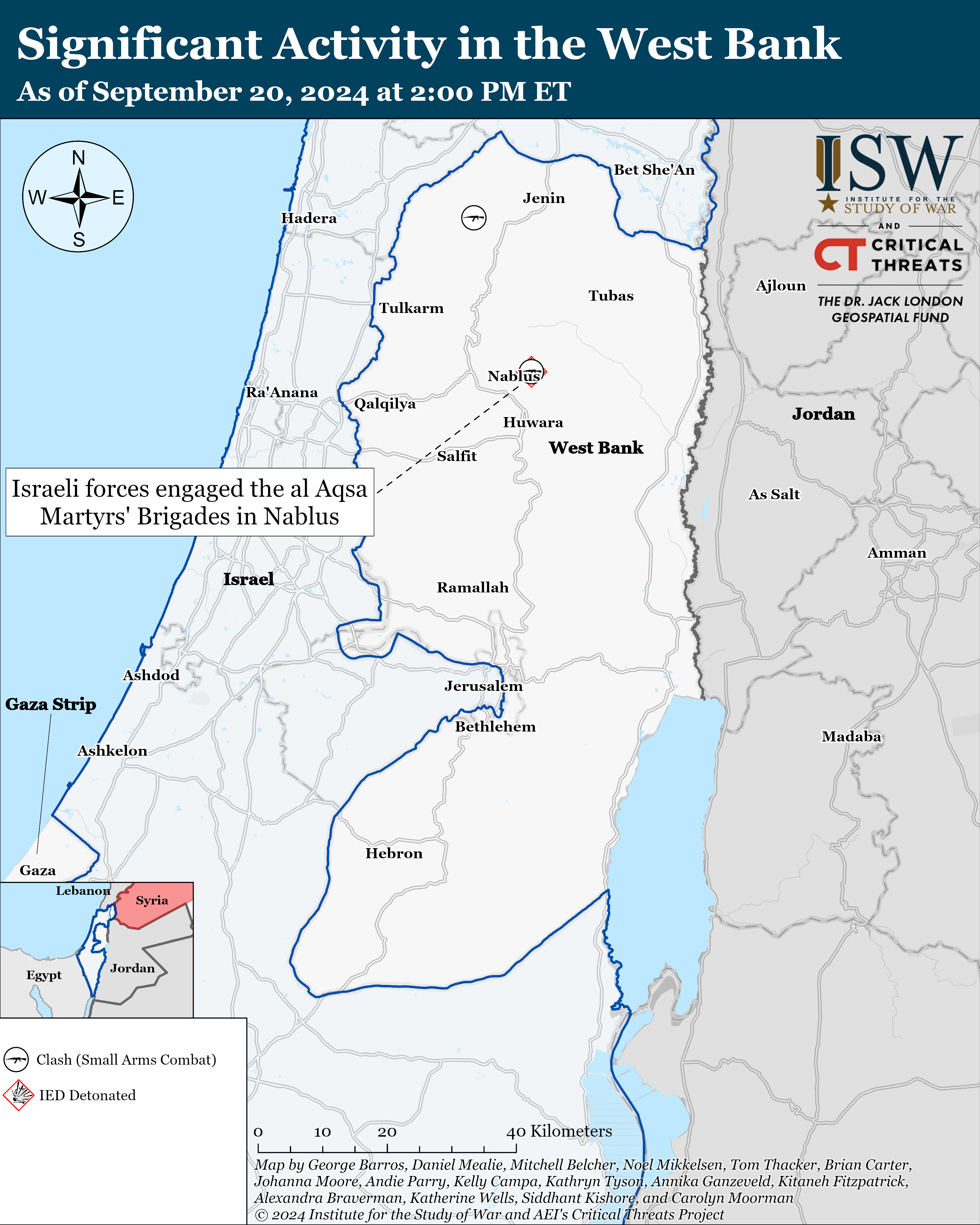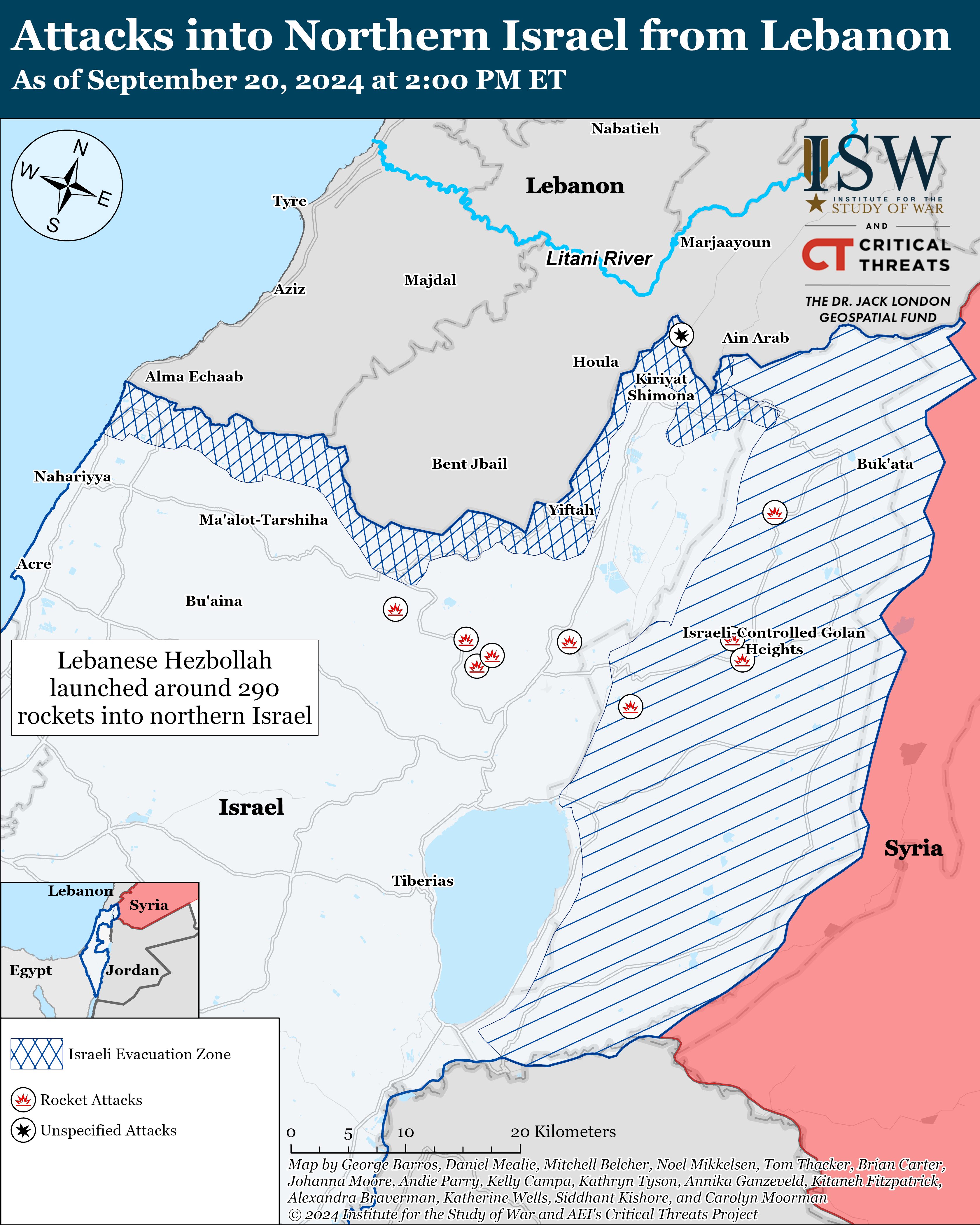Information Cutoff: 2:00pm ET
The Iran Update provides insights into Iranian and Iranian-sponsored activities abroad that undermine regional stability and threaten US forces and interests. It also covers events and trends that affect the stability and decision-making of the Iranian regime. The Critical Threats Project (CTP) at the American Enterprise Institute and the Institute for the Study of War (ISW) provides these updates regularly based on regional events. Click here to see CTP and ISW’s interactive map of Israeli ground operations. This map is updated daily alongside the static maps present in this report.
CTP-ISW defines the “Axis of Resistance” as the unconventional alliance that Iran has cultivated in the Middle East since the Islamic Republic came to power in 1979. This transnational coalition is comprised of state, semi-state, and non-state actors that cooperate to secure their collective interests. Tehran considers itself to be both part of the alliance and its leader. Iran furnishes these groups with varying levels of financial, military, and political support in exchange for some degree of influence or control over their actions. Some are traditional proxies that are highly responsive to Iranian direction, while others are partners over which Iran exerts more limited influence. Members of the Axis of Resistance are united by their grand strategic objectives, which include eroding and eventually expelling American influence from the Middle East, destroying the Israeli state, or both. Pursuing these objectives and supporting the Axis of Resistance to those ends have become cornerstones of Iranian regional strategy.
We do not report in detail on war crimes because these activities are well-covered in Western media and do not directly affect the military operations we are assessing and forecasting. We utterly condemn violations of the laws of armed conflict and the Geneva Conventions and crimes against humanity even though we do not describe them in these reports.
Israel appears to be exploiting disarray in Lebanese Hezbollah in order to inflict further damage upon the group. The Israel Defense Forces (IDF) conducted an airstrike in southern Beirut on September 20, killing several senior commanders in Hezbollah’s Radwan special operations forces unit.[1] The targeted individuals included Ibrahim Aqil, who was the overall Radwan commander. He was also a member of the Hezbollah Jihad Council, which oversees the group’s military operations. That Israel detected and was able to target such a sensitive meeting suggests that Hezbollah is suffering from lapses in operational security—possibly caused by Israel detonating the pagers and personal radios used by Hezbollah members.[2] These detonations compromised Hezbollah’s primary and secondary means of communication. CTP-ISW previously observed that Hezbollah could revert to less secure methods of communication, such as phones and radio relays, in order to rapidly restore communications.[3] Doing so would leave Hezbollah vulnerable, given that Israel could intercept these signals.
Hezbollah remains a capable fighting force that will overcome the disruption to its command-and-control and communications systems. Hezbollah has organized its forces in a conventional military structure that is designed to withstand and resolve these kinds of disruptions. The detonation of pagers and personal radios and the killing of senior Radwan commanders will thus generate only temporary effects on Hezbollah's military effectiveness. Hezbollah will recover given sufficient time to do so. Hezbollah also has Iranian-backed allied militias in Iraq, Syria, and Yemen that have not suffered any disruption to their own command-and-control and communications systems.
In the event of a major Israeli offensive into Lebanon, the IDF will have certain advantages that it did not in its war against Hezbollah in 2006 but will also face new challenges. The IDF is now more battle-tested and experienced from its time fighting Hamas in the Gaza Strip. The IDF has had time to practice complex maneuver operations against a deeply entrenched enemy force. The IDF 98th Division, for instance, has fought extensively in the Gaza Strip and is now deployed to the Israel-Lebanon border.[4] On the other hand, Hezbollah has a significantly more competent force than it did in 2006.[5] Hezbollah forces are more experienced given their participation in protracted campaigns fighting for Bashar al Assad in Syria. The Axis of Resistance is furthermore positioned to attack Israel from Iraq, Syria, and Yemen in a way that they were not in 2006.
Iranian-backed Iraqi militias have indicated that they would intervene in an Israel-Hezbollah war, which would risk intensifying the conflict across the Middle East. Kataib Hezbollah pledged on September 17 to send fighters and materiel to support Hezbollah against Israel.[6] Kataib Sarkhat al Quds—formerly known as Ashab al Kahf—separately announced on September 19 that it will soon launch a “new phase” of operations against Israel.[7] Abu Ala al Walai—the secretary general of Kataib Sayyid al Shuhada—lastly sent a message to Hezbollah Secretary General Hassan Nasrallah on September 20, in which he suggested that Iranian-backed Iraqi forces could deploy to Lebanon and fight alongside Hezbollah.[8] This public messaging is likely meant to deter Israel from launching a major military offensive into Lebanon, as CTP-ISW previously assessed, but could reflect the militias’ willingness to intervene as well.[9] The IDF conducted an airstrike south of Damascus on September 20, killing a senior Kataib Hezbollah official, underscoring the military presence that the militia has near the Israel-Syria border.[10]
The United States does not expect Israel and Hamas to reach a ceasefire-hostage agreement in the coming months, according to the Wall Street Journal.[11] Anonymous US officials told the outlet that Hamas has made demands in the negotiations and then refused to accept a deal after the United States and Israel accepted those demands. This behavior has led international negotiators to doubt that Hamas seriously wants a deal. Senior US officials, including Secretary of State Antony Blinken, have similarly questioned whether Hamas is sincerely looking to reach a deal.[12] The officials also cited disagreement between Israel and Hamas about hostage-prisoner swaps as an obstacle in negotiations. The officials added that Israel detonating pagers and personal radios owned by Lebanese Hezbollah members has further complicated diplomatic engagement with Hamas. An anonymous Arab official similarly said that there was “no chance” of a ceasefire-hostage agreement after Israel detonated the pagers and personal radios.
Key Takeaways:
- Lebanon: Israel appears to be exploiting disarray in Lebanese Hezbollah in order to inflict further damage upon the group. The IDF conducted an airstrike in southern Beirut killing several senior commanders in Hezbollah’s Radwan SOF unit.
- Lebanon: In the event of a major Israeli offensive into Lebanon, the IDF will have certain advantages that it did not in its war against Hezbollah in 2006 but will also face new challenges. The IDF and Hezbollah have both gained combat experience since then.
- Iraq: Iranian-backed Iraqi militias have indicated that they would intervene in an Israel-Hezbollah war, which would risk intensifying the conflict across the Middle East. These militias are active near in Syria near the Israeli border.
- Gaza Strip: The United States does not reportedly expect Israel and Hamas to reach a ceasefire-hostage agreement in the coming months. Hamas has made demands in the negotiations and then refused to accept a deal after the United States and Israel have accepted those demands.
Gaza Strip
Axis of Resistance objectives:
- Erode the will of the Israeli political establishment and public to sustain clearing operations in the Gaza Strip
- Reestablish Hamas as the governing authority in the Gaza Strip
An IDF soldier was severely injured in an engagement with Palestinian militias at an unspecified location in the southern Gaza Strip on September 20.[13] The soldier was from the 50th Battalion in the Nahal Brigade. The soldier is currently receiving medical treatment. [14]
Palestinian Islamic Jihad (PIJ) detonated an explosively formed penetrator targeting Israeli forces east of Rafah city on September 20.[15]
West Bank
Axis of Resistance objectives:
- Establish the West Bank as a viable front against Israel
Israeli forces have engaged Palestinian fighters in at least two locations in the West Bank since CTP-ISW's last data cutoff on September 19.[16] The al Aqsa Martyrs’ Brigades fired small arms and detonated improvised explosive devices (IED) targeting Israeli forces in Nablus.[17]
The IDF conducted an airstrike that killed a Palestinian militia commander in Qabatiya, south of Jenin, on September 19.[18] The al Aqsa Martyrs’ Brigades acknowledged on September 20 the deaths of two of its members and five PIJ members in Qabatiya.[19]
 |
This map is not an exhaustive depiction of clashes and demonstrations in the West Bank.
Southern Lebanon and Golan Heights
Axis of Resistance objectives:
- Deter Israel from conducting a ground operation into Lebanon
- Prepare for an expanded and protracted conflict with Israel in the near term
- Expel the United States from Syria
Lebanese Hezbollah has conducted at least 12 attacks into northern Israel since CTP-ISW's last data cutoff on September 19.[20] Hezbollah launched approximately 290 rockets at Israeli military positions in retaliation for Israeli airstrikes in southern Lebanon.[21]
Iran and Axis of Resistance
Iran is helping the Houthis target US MQ-9 drones, according to NBC News, which has enabled the Houthis to down or damage several in recent months.[22] The anonymous US officials speaking to NBC News did not specify how Iran was helping the Houthis in this regard. NBC News noted that the US adversaries have previously jammed the communication link between the drone and its operator. US officials also confirmed that the Houthis have downed at least six US MQ-9 drones since October 2023.
Houthi Supreme Political Council Chairman Mahdi al Mashat called for the continued fight against the Houthis’ enemies, stating that “we have the appropriate deterrents to achieve that,” during a speech on September 20.[23] Mashat demanded the removal of foreign powers from Yemen and criticized Israel for detonating pagers and personal radios belonging to Lebanese Hezbollah members.[24] Houthi spokesperson Mohammed Abdul Salam similarly condemned the Israeli attack on Hezbollah in a post on X (Twitter).[25]
The Islamic Revolutionary Guard Corps (IRGC) Ground Forces announced that they engaged and destroyed a "terrorist group" trying to infiltrate Iran near Marivan, Kurdistan Province.[26] Iranian media reported that the IRGC killed several militants, including Komala leader Ribwar Karimian, during the clashes. Iranian media had previously claimed that Komala member Amjad Hossein Panahi was also killed in the fighting.[27] However, in a separate interview with Voice of America Persian, Hossein Panahi stated that reports of his death are false, although he confirmed Ribwar Karimian’s death.[28]
Iranian Supreme Leader Office Chief of Staff Mohammad Mohammadi Golpayegani said on September 20 that Iran is “expected soon” to retaliate for Israel killing Hamas political leader Ismail Haniyeh in Tehran.[29] Iranian officials have said regularly that they will retaliate against Israel for the killing.[30]
Iranian President Masoud Pezeshkian met with Venezuelan Transportation Minister Ramon Velasquez in Tehran on September 19.[31] Pezeshkian called for expanding bilateral economic cooperation. Velasquez invited Pezeshkian to attend Venezuelan President Nicolas Maduro’s inauguration ceremony and requested Iranian support for Venezuela joining BRICS. Iranian Foreign Affairs Minister Abbas Araghchi and Iranian Defense and Armed Forces Logistics Minister Brigadier General Aziz Nasir Zadeh also met with Velasquez in Tehran on September 18 and 19, respectively.[32]
[1] https://idfanc.activetrail dot biz/ANC200920245659845758 ; https://x.com/idfonline/status/1837112976718901560 -east_news_article_pos1 ; https://www.washingtonpost.com/world/2024/09/20/israel-lebanon-hezbollah-hamas-war-news-gaza-palestine/#link-DYWAI5TGNVDA5NENA2IVZLK2N4 ; https://www.nytimes.com/2024/09/20/world/middleeast/ibrahim-aqeel-hezbollah-commander-what-to-know.html
[2] https://www.understandingwar.org/backgrounder/iran-update-september-17-2024 ; https://www.understandingwar.org/backgrounder/iran-update-september-18-2024
[3] https://www.understandingwar.org/backgrounder/iran-update-september-18-2024
[4] https://www.jpost dot com/israel-hamas-war/article-816551 ; https://www.i24news dot tv/en/news/israel-at-war/artc-over-60-miles-of-underground-terror-tunnels-destroyed-by-98th-division-since-start-of-war
[5] https://missilethreat.csis.org/country/hezbollahs-rocket-arsenal/ ; https://www.fdd.org/analysis/2024/07/09/a-greatly-expanded-arsenal-means-this-is-not-the-hezbollah-of-2006/
[6] https://t.me/centerkaf/4586
[7] https://t.me/aishab_alkahf/217
[8] https://almanar.com dot lb/12497608 ; https://www.alahednews.com dot lb/article.php?id=74607&cid=116
[9] https://www.criticalthreats.org/analysis/iran-update-september-18-2024-66eb677138120
[10] https://t.me/centerkaf/4596
[11] https://www.wsj.com/world/middle-east/israel-hamas-deal-unlikely-before-end-of-bidens-term-u-s-officials-say-efc21510?mod=middle-east_news_article_pos4
[12] https://www.cnn.com/2024/06/12/politics/blinken-expresses-frustration-at-changes-to-gaza-ceasefire-deal-requested-by-hamas/index.html
[13] https://x.com/idfonline/status/1837143720090608057
[14] https://x.com/idfonline/status/1837143720090608057
[15] https://t.me/sarayaps/18595
[16] https://t.me/elaqsa_1965/7535; https://t.me/sarayajneen/1596
[17] https://t.me/elaqsa_1965/7535
[18] https://x.com/idfonline/status/1837044988669997136
[19] https://t.me/elaqsa_1965/7532
[20] https://t.me/mmirleb/7046 ; https://t.me/mmirleb/7053 ; https://t.me/mmirleb/7057 ; https://t.me/mmirleb/7060 ; https://t.me/mmirleb/7063 ; https://t.me/mmirleb/7066 ; https://x.com/GLZRadio/status/1837088630583554129 ; https://t.me/mmirleb/7069 ; https://t.me/mmirleb/7072 ; https://t.me/mmirleb/7075 ; https://t.me/mmirleb/7078 ; https://t.me/mmirleb/7089
[21] https://x.com/GLZRadio/status/1836991171748389326 ; https://x.com/GLZRadio/status/1837083227279819027 ; https://x.com/idfonline/status/1837101212807659750 ; https://x.com/idfonline/status/1837101215533896117 ; https://x.com/GLZRadio/status/1837088630583554129 ; https://x.com/idfonline/status/1837101215533896117
[22] https://www.nbcnews.com/investigations/iran-helping-houthi-rebels-yemen-target-us-reaper-drones-us-officials-rcna171834
[23] https://x.com/Almasirahbrk/status/1837176712829735197; https://x.com/Almasirahbrk/status/1837179116174377216; https://x.com/Almasirahbrk/status/1837178753820098895
[24] https://x.com/Almasirahbrk/status/1837179236517306410
[25] https://x.com/abdusalamsalah/status/1837154027055858162
[26] https://farsnews dot ir/M_r7726/1726752581493582933
[27] https://www.hamshahrionline dot ir/news/882905
[28] https://ir.voanews.com/a/iran-komle-party-member-voa-farsi-voice/7791055.html
[29] https://www.entekhab dot ir/fa/news/818923
[30] https://www.understandingwar.org/backgrounder/iran-update-september-19-2024; https://www.understandingwar.org/backgrounder/iran-update-september-4-2024; https://understandingwar.org/backgrounder/iran-update-august-4-2024; https://understandingwar.org/backgrounder/iran-update-july-31-2024
[31] https://president dot ir/fa/154124
[32] https://www.understandingwar.org/backgrounder/iran-update-september-19-2024; https://defapress dot ir/fa/news/691904; https://mfa dot ir/portal/newsview/753432





